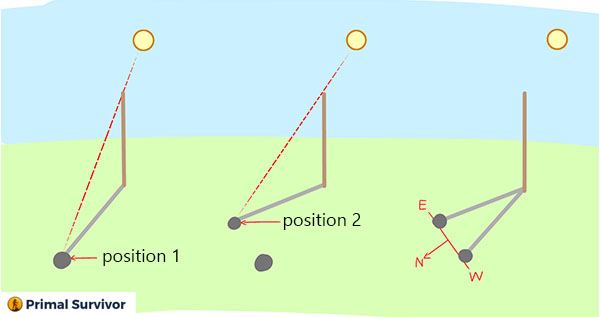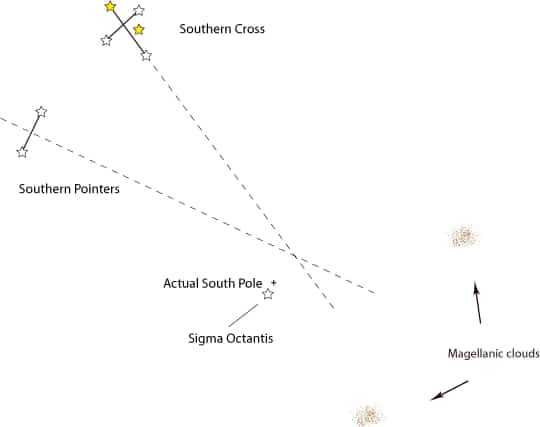There have been dozens of movies and TV shows where the protagonists get lost in the wilderness.
No worries!
They just look at which direction the moss is growing on trees to determine find north.
But many of the things you’ve heard about navigating in the woods without a compass and finding north are probably false – starting with the moss trick.
(By the way, can you even identify moss? Because moss can look a lot like lichen!)
Following North Isn’t Always a Good Idea
Even if you can find north, it doesn’t mean you should just start walking north. When lost in the wilderness, you are better off:
1) Going downhill: There are more likely to be towns at the bottom of the mountain than above. And the conditions for survival are better downhill than at the top of a mountain. Note: There have been many cases of kids getting lost in the woods and going up mountains to “get a better view.” With less water, shelter, and colder temperatures there, this is a deadly mistake.
2) Follow a stream or river: This is likely to take you to civilization. And much more than blindly heading north would!
3. Staying put: If you aren’t confident in your abilities to navigate, it’s better to stay where you are for help to arrive.
When Knowing How to Find North Is Useful
Good survivalists always have a backup. For navigation, the backup is the skill of being able to find north.
For example, if I were to lose my survival compass while hiking, I could use one of the tricks below to find north.
If I were to get lost in the wilderness, knowing how to follow north would prevent me from walking in circles. This has been scientifically proven to occur!
Read more about the different types of compass.
Below are the most reliable methods of finding north for navigation.
1. Navigating with Your Wrist Watch and the Sun
This is a cool trick for navigating without a compass which works. Of course, you have to be wearing a wristwatch for it to work, and it also has to be a sunny day.
In the Northern Hemisphere:
Hold your watch flat and point the watch’s hour hand towards the sun. Make a line between the hour hand and the 12 o’clock mark. This will give you a North-South line. North is the direction away from the sun.
At 12 o’clock, you won’t be able to make a line between the hands. This is okay. Just use the 12 mark as your line.
In the Southern Hemisphere:
Hold your watch flat and point the 12 o’clock mark towards the sun. Make a line between the 12 mark and the hour hand. This will be your North-South line. North is the direction away from the sun.
*This also works with a digital watch, but you have to imagine where the watch hands would be!
2. Using the Shadow and Stick Method

In the Northern Hemisphere:
1. Put a long, straight stick vertically in the ground in a flat place. You don’t want hilly ground because it will distort the shadow.
Note where the end of the shadow is. Place a marker on it (like a rock). This is your Western side.
2. Wait about 20-30 minutes. Then put a marker at the edge of the new shadow. This will be your Eastern Side.
3. Draw a line between the two markers. The first marker is West, and the second marker is East.
Now that you’ve got West and East, you can bisect the line to find your North-South line.
The obvious downside of this method is that it takes a lot of time. And it isn’t going to prevent you from walking in circles as you go. So, you’ll have to constantly stop and make a new shadow compass to check whether you are going in the right direction!
3. Using the Stars at Night
In the Northern Hemisphere:
This one should be pretty obvious. Just look for the North Star, aka Polaris. If you aren’t sure which one is Polaris, look for the Big Dipper.
Imagine a line between the last two stars at the end of the dipper. Extend this line about 5x the distance between those two stars, and you’ll be at Polaris.
In the Southern Hemisphere:

Find the Southern Cross, and this will be the way south. As a Northerner, I wasn’t familiar with the Southern Cross until I started traveling.
The Southern Cross looks more like a kite shape when you connect the stars with an imaginary line. There are always two “pointer stars” nearby.
It is a bit trickier to navigate with the Southern Cross. You’ve got to draw an imaginary line from the Cross and another line perpendicular between the Pointer stars. Extend these lines out. Below where they intersect is South.
Putting These Navigational Tricks to Use
As I mentioned before, people have a proven tendency to walk in circles. So, you will need to constantly stop and check which direction is north to make sure you are moving in a straight line. This isn’t very conducive to travel in survival situations!
Alternatively, you can use this navigational trick to stay on course.
- Note a landmark at your current position.
- Draw a line on the ground pointing North (or whatever direction you want to travel).
- Use the line you just drew to identify a landmark in that direction. The landmark should be easily visible in your sight range.
- Walk to the landmark.
- When you reach the landmark, draw a line on the ground that points toward your previous position.
- Use the new line to find a new landmark ahead.
- Continue doing this so you keep on course!
Have you ever been lost in the wilderness? How did you find your way? Let us know in the comments.



Unfortunately, the Stick and Shadow method doesn’t work as it depends on the time of day.
Around noon it will be right, but at 6am position 1 will be S and position 2 N. 6pm the reverse of that and at other times somewhere inbetween.
So relying on this could be very dangerous unless you know the time and then the Watch method is easier.